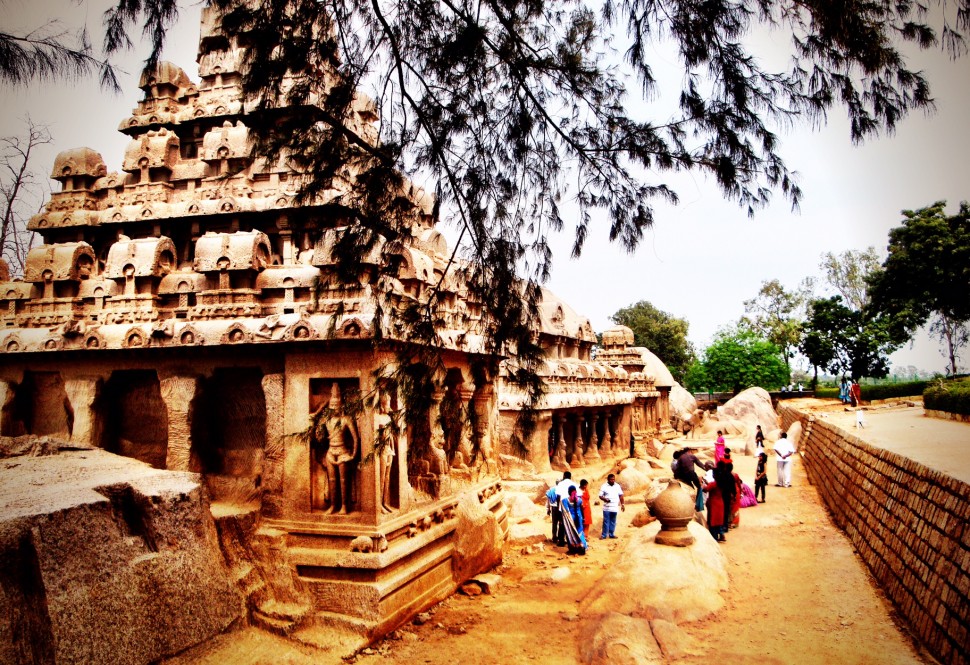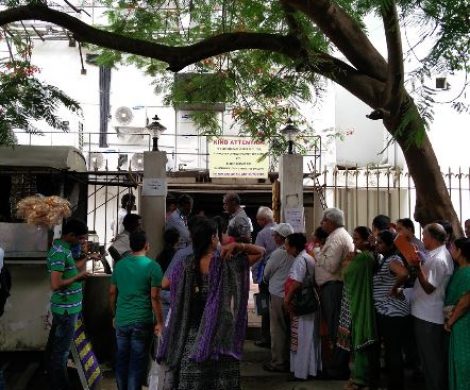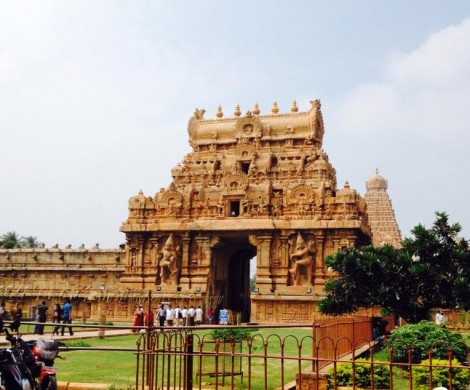
In December 2010, nearly 6 years after I had moved to Malaysia, I went to Chennai to visit my grandmother. My cousin Karthik, who had recently moved to Chennai from Bangalore was giving me company. One Sunday morning with nothing to do, and the day looming large ahead of us, I turned to him and said, – “Hey, do you want to go to Mahabs?”
Karthik looked at me like I had lost my mind. But it turned out he had not been to Mahabalipuram either! It was an impulsive decision but I suddenly knew that I really wanted to go there and see the famous Shore temple and the many historic monuments from the Pallava dynasty, known as the Group of Monuments at Mahabalipuram classified under UNESCO World Heritage Site.
I knew someone, who knew someone, who could arrange a car with a driver to take us. An hour after that conversation, Karthik and I were on the East Coast road (ECR) on our way on the hour-long journey to Mahabalipuram!
The ECR Road from Chennai makes the journey fairly easy and smooth and the last few miles are particularly scenic as the road runs parallel to the coastline of the Bay of Bengal, and you get glimpses of the blue sea at a distance.

Mamallapuram, as it is known in Tamil dates back to the Pallava dynasty in the 7th century. It was a bustling port town under the Pallava rulers. Today, it’s a tourist town known for the ancient monolithic structures and beautiful temples dotting its shoreline, mostly carved out of granite, and are considered among the oldest existing examples of South Indian Dravidian architecture.
Stone carving has always been a tradition in this historic town. It is this tradition that created the temple wonders that Mahabalipuram is famous for. Stone carving is alive and thriving even today in many workshops in town.

Once we reached the heart of the town, our driver suggested that we start by visiting the Pancha Rathas, or the Five Chariots, moving on to the Cave Temples and finally the Shore Temple. To enter the monument complex, we had to buy tickets. We told our driver to find a parking spot and take a break for the next 30-40 minutes till we finished with the Pancha Rathas. I wanted to walk around unencumbered, so I left my handbag in the car, only carrying some cash in the pocket of my jeans and a camera in my hand.
At the ticket counter, I found two windows, one for Indians who could buy tickets for Rs.20 each and one for foreigners, who had to shell our Rs.250 per ticket! I paid Rs.40 for two tickets and went back to my waiting cousin and told him amusedly about the price difference (something I had never encountered before, but found out later is actually quite common in prominent monuments such as Taj Mahal) as we waited in line to enter the Pancha Ratha complex. The line moved quickly and soon it was our turn and I showed the tickets to the guard and started to go through the entrance. Suddenly, he yelled at me to stop.
Startled, I turned around and found him waving at me angrily – “You have to buy foreigner ticket. 100 Rupees. This is Indian ticket.”
Taken aback, but mostly amused, I told him I was an Indian. I switched to Tamil and asked him if I looked like a foreigner.
“Yes, yes, you foreigner. Buy Foreigner ticket. 100 rupees.”
Karthik, who was a few steps ahead of me and had come back to witness this exchange looked very entertained at this unexpected development. He tried to step in and talk to the guy in Tamil and assure him that I was very much Indian and I was his sister.
I continued to speak to him in Tamil and asked him – How many foreigners do you know who speak fluent Tamil?
To my surprise he said (In Tamil) – “So many of you foreigners come here, learn the language and speak not only Tamil, but several Indian languages. I have seen white people who come here to learn classical dance and music, and become totally Indian. That won’t fool me. Show me your ID or passport.”
Since I had left my handbag in the car, along with my phone I had no ID on me. Nothing to prove I was who I said I was. For the first time in that encounter, I realized how crazy this situation was.
I tried to speak to him in best colloquial Tamil trying to convince him that I was very much an Indian, that my ID was in my handbag which was in the car and I had no way of reaching the driver just then.
By this time, the line behind us was starting to get impatient, because he was the only guard/ticket checker at the gate and he was holding up the line. I used that to my advantage. In a very annoyed tone, I told him in Tamil to stop harassing me and get on with his duties, because I wasn’t going to waste my time arguing with him, and briskly walked away. Karthik couldn’t stop laughing for the next ten minutes and took the opportunity to tell me that coloring my hair a dark blond with lighter streaks was not helping my case!
I was wearing jeans, but had an Indian cotton kurti on top. But my hair, which is a mass of unruly curls was indeed a dark blonde that seemed even lighter in the glaring sunshine. And my large Audrey Hepburn sunglasses covered half my face. There is no way anyone in Chennai city would have mistaken me for a foreigner, but I guess in small town Mahabalipuram, anyone dressed like me was considered one!
Pancha Rathas
The Pancha Ratha complex consists of five rathas, or Chariots, and are carved out of a single rock. They are the perfect example of ancient Indian monolithic architecture. They are attributed to the reign of Pallava King Mahendravarman I and his son Narasimhavarman I (also called Mamalla, the great warrior) in the late 7th century CE.
The structures are popularly called the Pancha Pandava Rathas (Chariots of the five Pandava Princes from the epic Mahabharata). They were named after each of the Pandava Princes (Yudishthir, also known as Dharmaraja, Bheem, Arjun, the twins Nakul-Sahdev) and their common wife, Draupadi. Many people refer to these structures are chariot temples, however, these are not temples, because construction was discontinued after the death of Narasimhavarman, and the structures were never consecrated.
Note: A structure must go through a formal consecration ceremony before the sculptures in them are considered to be deities of divine status.
Also, the chariots have no connections to the tales of the Mahabharat and its central characters. It is believed that the Pallava rules planned the rock structures as models based on prototypes of ancient rathas built in wood. However, the name Pancha Rathas has stuck.

Interestingly, these chariots were buried under the sand for centuries until they were excavated by the British 200 years ago. This complex is part of the UNESCO World heritage site.
From the Pancha Rathas, we drove over to a hillock overlooking the Coromandel coast of the Bay of Bengal to see the cave temples, about 4km away. On the way, we stopped by to take a look at a massive natural rock boulder known as Krishna’s Butter Ball. In Hindu mythology Lord Krishna had an insatiable appetite for butter, and as a child would often sneak a handful from his mother’s butter jar.

Cave Temples
Cave temples are known as Mandapams and they are fascinating. They are essentially shrines or mini sanctuaries scooped out of rock faces. They consist of a pillared hall and one or more sanctums at the rear of the hall and the walls are covered in exquisite bas-reliefs depicting tales from the puranas.
Of the eleven Mandapams in Mahabalipuram, the most notable are the Varaha Cave Temple, Krishna Cave Temple, Panchapandava Cave Temple, and the Mahishasuramardini mandapam.
Panchapandava Mandapam
This is an unfinished cave sanctuary on top of a hill range along with other cave temples in Mahabalipuram. It has the longest cavern of all the cave sanctuaries indicative of an unfinished circumambulatory passage that was meant to go around the shrine, within the cave. It contains a stunning relief carving of Lord Krishna as a young boy lifting Mount Govardhan. According to legend, Lord Indra, the God of rain and thunder is offended by the villagers of Vrindavan when they stop their special offerings to him after young Krishna convinces them that instead of praying to a God for a natural phenomena, they should be nurturing nature instead. Indra lets loose a torrential storm deluging the village. To save his kinsmen, Krishna lifts Mount Govardhan on his little finger and everyone takes refuge under its canopy.
References in ancient Tamil literature indicate that the Govardhan Fresco was originally a freestanding bas relief, similar to Arjuna’s Penance nearby, commissioned by the Pallava kings. Natural elements had caused a great deal of damage to the fresco, and later dynasties such as the Cholas and the Vijayanagar empire repaired it and added the extended mandapam to the fresco turning it into a cave sanctuary.
Arjuna’s Penance
Near the Krishna Mandapam is one of the most beautiful, and biggest open-air relief carvings I have ever seen. It is perhaps ancient India’s version of street art. Sculpted on the face of two enormous adjacent rocks, this bas-relief with intricate carvings is also known as the Descent of the Ganges.
Interestingly, there are two legends associated with this monument.
According to one legend, the scenes depicted in the bas-relief are from the story of the descent of the sacred river Ganges to earth from the heavens led by King Bhagiratha, a forefather of Lord Rama (from the Ramayana).
The alternate legend says this is a depiction of the Pandava prince Arjuna performing severe austerities in order to obtain Lord Shiva’s weapon.
The symbolism of the relief supports either story. Both stories were interpreted in a manner flattering to the Pallavas; the heroic Arjuna as a symbol of the rulers, and the Ganges as a symbol of their purifying power.
A natural cleft populated by nagas (snakes) separates the two halves of the relief. Apparently, this relief is best seen during or after the monsoons as water flows down the cleft in the middle of the two rocks, simulating a natural waterfall (the descent of the Ganges) bringing the symbolism to life.
Mahishmardini Cave
Mahishasura Mardini Cave is located at the base of a diorite hillock, with another ancient structure – the Olakneswara Temple on top of the hill. It contains several beautiful reliefs which showcase the artistic prowess of the sculptors of the Pallava kingdom. This cave sanctuary is not finished and does not contain any inscriptions.
The Lighthouse
Mahabalipuram was a busy port under the Pallava Kingdom. The coastline used to be a couple of miles further inland than today. It is believed that bonfires were lit in the Olakneswara temple to guide mariners back in the day. It is considered to be India’s oldest lighthouse built around 640 AD by Pallava King Rajasimhan. In 1887, the British made modifications to the ruins of the Olakneswara Temple in order to build an oil lamp lit lighthouse on top of it.
In 1904, the British commissioned a new lighthouse with a circular masonry tower made of natural stone, which stands right next to the old lighthouse.

Shore Temple
The shore temple, as the name suggests overlooks the Bay of Bengal. The temple has survived the sea’s fury for 12 centuries outlasting other temples along the shore. Its location near the sea has resulted in considerable erosion of the temple’s superstructure.
Construction of the temple is attributed to Pallava king Rajasimha, the son of King Narasimhavarman who is credited with the other monuments mentioned above.
According to surviving historical records, European sailors gave it the name Seven Pagodas when they saw the structures on the seashore, possibly due to the similarity in appearance to a Pagoda.
This temple complex is believed to be the last in a series of temples that existed in the submerged coastline. After the Tsunami hit the Indian Ocean 2004, the Bay of Bengal was also affected by it. In the aftermath, an outline of other temple structures appeared in the coastline, and exposed some ancient rock sculptures of lions, elephants, and peacocks that used to decorate temple walls during the Pallava period.
The Shore Temple is an exquisite masterpiece from 8th century India, a rare gem of architectural and historical importance. After it was recognized as a UNESCO World Heritage Site, preservation efforts have been made and today the Archaeological Society of India manages it.
The waves of the Bay of Bengal lash against the embankment around the temple complex and the blue-green waters of the sea merge with the blue sky. Against this backdrop, the temple stands majestic casting a magical spell on visitors.
I am glad I decided to make this impulse trip to Mahabalipuram. Visiting the main monuments doesn’t take more than 3 hours. We were home in time for evening tea. It felt almost unreal to be back in urban civilization after a day spent walking through the ruins of an era gone by. It’s a date with history and one that leaves you with many stories, and, even more, questions.






















